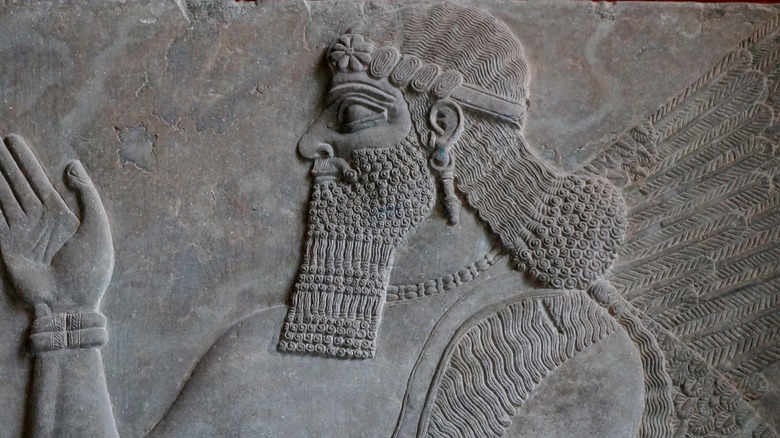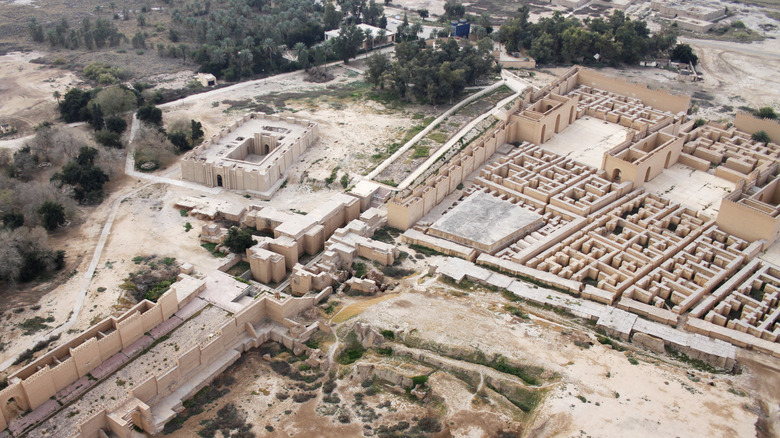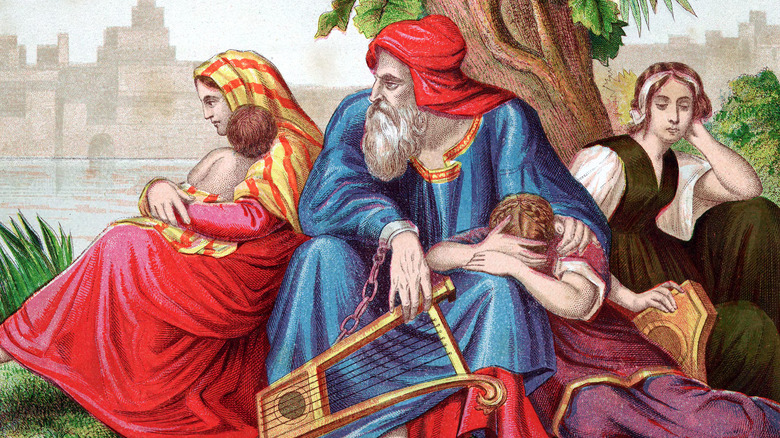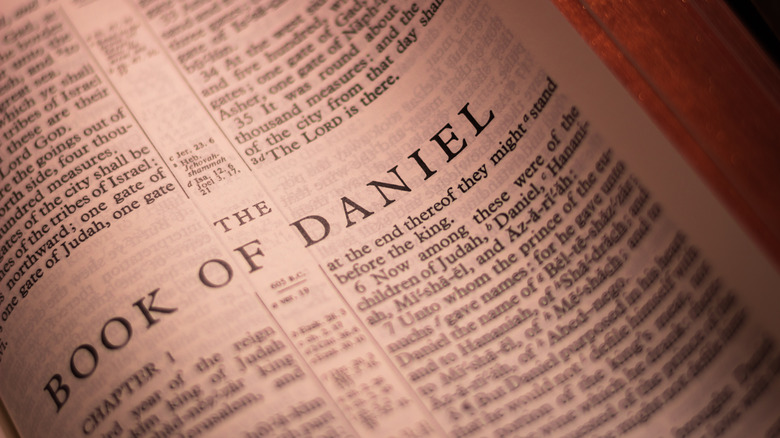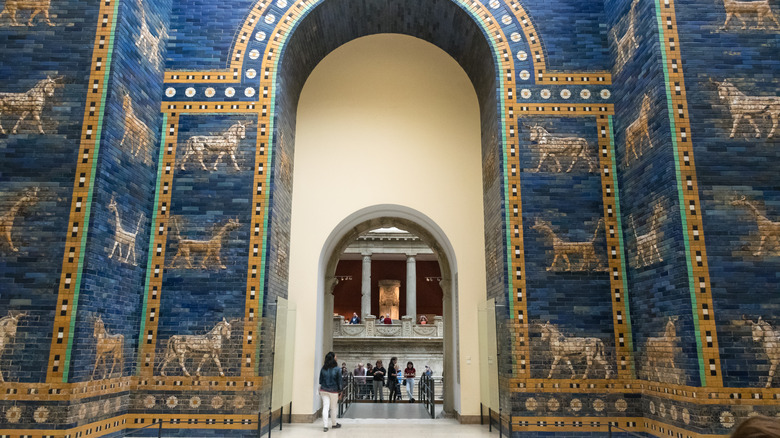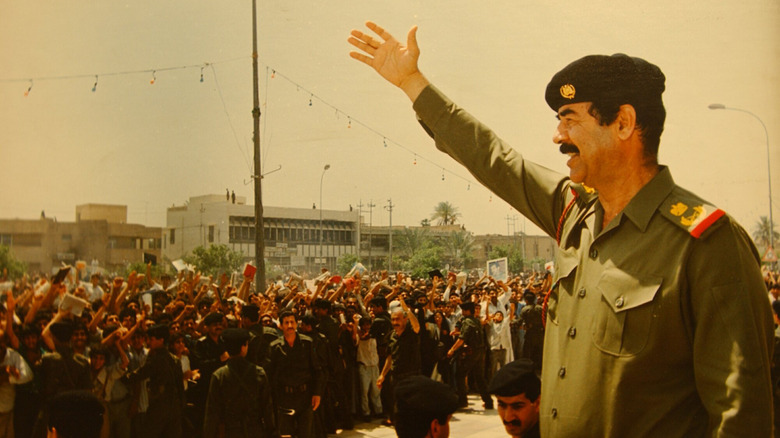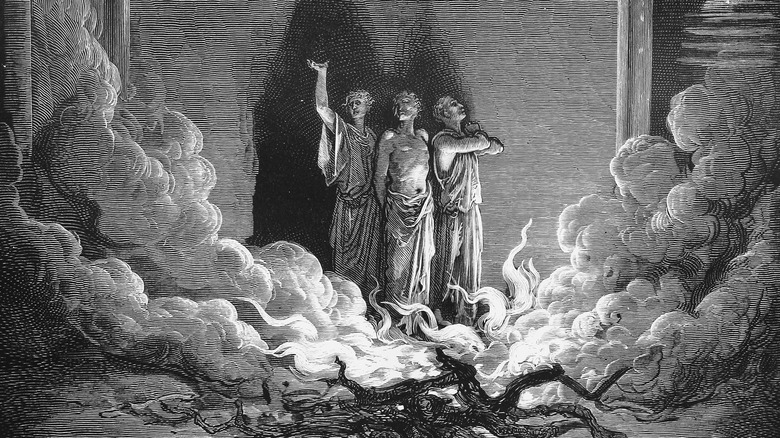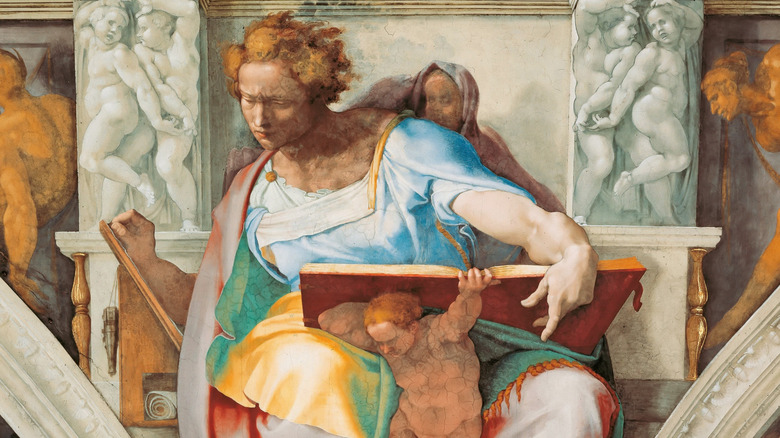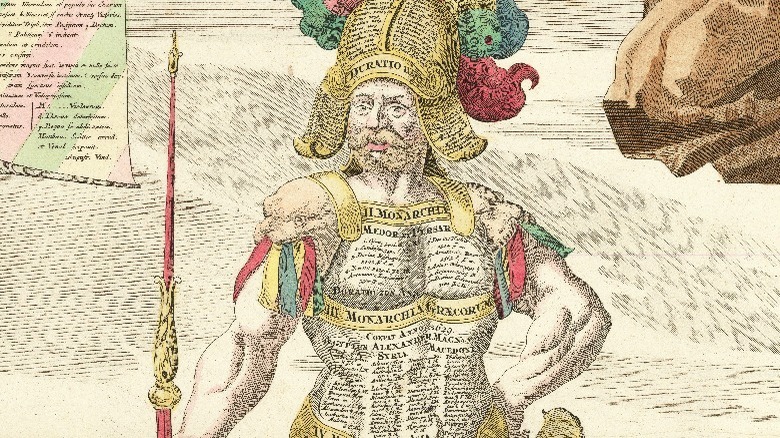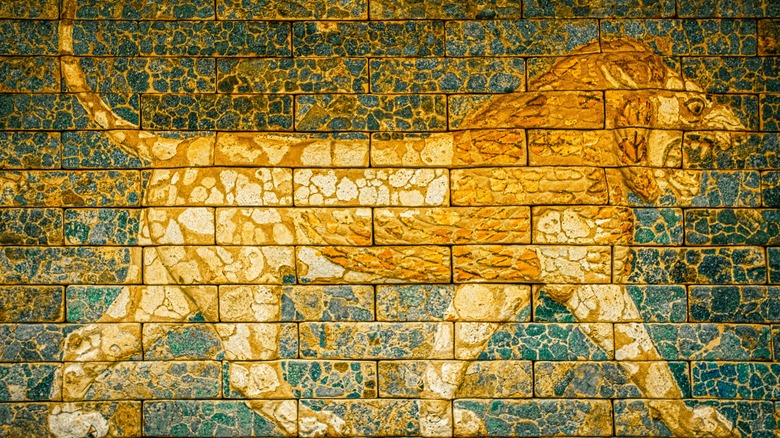The Untold Truth Of King Nebuchadnezzar Of Babylon
In the ancient world, memory represented a type of cultural currency. Without photographs, computers, or printing presses, ancient people sought generational renown. They longed for future generations to sing their praises, representing a form of immortality or, as the classical Greeks called it, kleos. The definition of kleos provides important insights into what motivated rulers of the past: "fame or glory attained through good deeds and hard work" (via Drink Kleos).
Of course, some people achieved fame for other reasons. In the case of the Babylonian king Nebuchadnezzar II, we could more fittingly call it infamy. You see, people still talk about this ancient ruler thousands of years later because of the terrifying punishments he instituted, his capricious mentality, and his awe-inspiring achievements. Some people also associate him with a strange mental illness that left the mighty ruler on his hands and knees, pawing at the earth like a bovine, per the Pharmaceutical Journal. (More on this later.)
From the legend of the Hanging Gardens of Babylon to the stunning Ishtar Gate, Nebuchadnezzar left testament to his mighty reign, per The Conversation. And he also made the list of principal villains in the Old Testament, by no means an easy achievement. What else do you need to know about this controversial figure? Let's dive into the untold truth of one of history's most fear- and awe-inducing rulers.
Nebuchadnezzar really lived
It's no exaggeration to say that the Neo-Babylonian warrior-king Nebuchadnezzar II was legendary. He ruled from 605 to 562 B.C., according to The Conversation. How far did his power stretch? Across Mesopotamia or the "Cradle of Civilization," nestled between the Tigris and Euphrates Rivers.
What does history tell us about Nebuchadnezzar's existence? Not only did he prove a great military leader, but he also devoted his rule to marvelous architectural feats. These monuments and structures would come to define ancient Babylon. In the case of the Hanging Gardens of Babylon, no archaeological remains of the structure exist today, and it's not clear that the gardens ever really existed. Yet, people still remember this wonder of the ancient world based on the impressive descriptions of it.
But not all of the Babylonian king's public works projects were based on esthetics. Some, like the fortifying of the city-state's walls, served a functional purpose. According to the Louvre, "The city was placed within a terrific defensive network consisting of two sets of walls that created a stronghold admired and dreaded by his enemies."
He ruled over two-thirds of Neo-Babylonian history
Not only did Nebuchadnezzar's reign change the shape, size, and look of Neo-Babylon, but it also stretched for an impressive 43 years (via the Louvre). During this time, Nebuchadnezzar II focused on just about every aspect of Babylonian public life. Besides military defense, he indulged in empire building, conquering neighboring peoples with a level of cruelty and ferocity still remembered today.
According to The Conversation, "Neo-Babylonian armies swept through the area, leaving a trail of destruction including that of the biblical kingdom of Judah, which was besieged and destroyed." The process of empire building left Nebuchadnezzar the ruler of whole nations of slaves, including Jews such as Daniel, Shadrach, Meshach, and Abednego.
Nebuchadnezzar translated his newfound wealth and prestige into impressive architectural projects fueled by the slaves he compelled back to Babylon. Why the focus on building? He wished to restore Babylon to its pre-Assyrian glory. (The Assyrians ruled before the Neo-Babylonian liberation of the city-state). These incredible works would not only make Babylon an astonishing place to visit, but it also cemented Nebuchadnezzar's renown as a famed leader. Unfortunately, absolute power corrupts absolutely, and such would be the case with the Babylonian leader.
Nebuchadnezzar inspired Kanye West
On November 24, 2019, Kanye West's first operatic work, "Nebuchadnezzar," premiered at the Hollywood Bowl, according to Forbes. West set the work in the 6th century B.C, during the historical king's reign, and it's based on the Book of Daniel's account found in the Old Testament. What drew West to this biblical character?
West could relate to various aspects of the ancient king's life, including his great celebrity and his struggles with mental illness. West also found parallels in terms of his spiritual journey towards God. According to media released before the show's premiere, West's work explores "Nebuchadnezzar's transition from wicked, imperious, self-declared ruler to a true believer who finds salvation in his faith" (via Rolling Stone).
What's another touchpoint between Nebuchadnezzar and West? The love of music, per The Conversation. The Babylonian king appears to have highly appreciated musicians and songs. So much so that he had the unveiling of the famed golden statue of himself done to the accompaniment of "the sound of the horn, pipe, lyre, trigon, harp, bagpipe, and every kind of music," according to the Book of Daniel via Biblia.
His name lives on thousands of years later
Besides Kanye West, other musicians and composers have also gotten in on the Nebuchadnezzar action through musical compositions. This includes works by the Italian composer Giuseppe Verdi and jazz pianist Marcus Roberts.
According to The Metropolitan Opera, Verdi's "Nabucco" takes place in 6th-century Jerusalem during the siege of Nebuchadnezzar (aka Nabucco). In true overdramatic Italian opera style, the nephew of the King of Israel, Ismaele, falls in love with Fenena, the daughter of Nebuchadnezzar. (She's being held hostage by Jewish high priest Zaccaria.) Between love triangles, jealousy, and intrigue, the opera takes a thousand twists. But like Kanye West's work, Verdi brings the story full circle with Nebuchadnezzar's religious conversion near the end of the work.
Marcus Roberts' "Nebuchadnezzar" features Middle Eastern flourishes and stylings, according to the Los Angeles Times.
Nebuchadnezzar features prominently in the Bible
Nothing beats the fame of being mentioned in the Bible, and Nebuchadnezzar receives far more than a bit of lip service. One of the famed book's ultimate villains, he gets serious airtime in 2 Kings, Ezekiel, Jeremiah, 2 Chronicles, Ezra, and Daniel (via Bible Study Tools).
The Babylonian ruler conquered Jerusalem and destroyed the Jewish temple built by Solomon, per Overview Bible. How did it get to this point? After the death of his father, Nabopolassar, in 605 B.C., Nebuchadnezzar came to the throne as the second ruler of the Chaldean dynasty (via Learn Religions). At his ascension to the throne, King Jehoiakim of Judah submitted to his rule. But three years later, Jehoiakim rebelled against Nebuchadnezzar (as well as the advice of the prophet Jeremiah), setting off a terrible chain of events that would lead to the subjugation of Judah.
During a three-month-long siege, Jehoiakim died passing political control to Jehoiachin. But this transition proved short-lived. At the end of the 90 days, Nebuchadnezzar razed the city, taking everything from Judah, including the king and 10,000 slaves. According to The Conversation, "Many scholars have noted that the historicity of the biblical account is supported by cuneiform sources. Indeed, this biblical account of the destruction is remarkably close to descriptions of the event found in Neo-Babylonian chronicles."
Nebuchadnezzar's most legendary public works
Nebuchadnezzar amassed an impressive list of architectural achievements during his reign, according to The Conversation. They include the Ishtar Gate and the Hanging Gardens of Babylon. The Ishtar Gate earned renown during the rule of Nebuchadnezzar for its eye-catching electric blue color and opulent symbols of lions, considered sacred to the goddess of love, Ishtar. Thousands of azure bricks with the king's seal have been excavated from the site (now located in modern-day Iraq), and they attest to the majesty of this formidable structure.
Interestingly, the story behind the Hanging Gardens of Babylon showcases a softer side to Nebuchadnezzar. According to World History Encyclopedia, the mighty king built the gardens for his wife, Amytis, who felt homesick and missed the forests and landscapes of her homeland in Persia. Where were these mythical gardens located? They are thought to have been situated roughly 250 miles north of modern-day Baghdad, in ancient Ninevah, though there is little evidence of their existence.
The result of these phenomenal public works projects? According to "The Untold Story of Native Iraqis: Chaldean Mesopotamians 5300 BC – Present" by Amer Hanna-Fatuhi, "[Nebuchadnezzar] was able ... to transform Babylon of Hammurabi into the most celebrated city in the ancient world." But the king's foresight didn't end with new monuments to his greatness. He also established one of the world's oldest museums of artifacts in his palace, even pre-dating the museum of Alexandria, which was formerly considered the oldest.
He bore the yoke of boanthropy
Nebuchadnezzar's reported mental illness is worth exploring because it had a significant impact on his reign. According to the Book of Daniel, Nebuchadnezzar "was driven away from mankind. He ate grass like an ox, and his body was drenched with the dew of heaven, until his hair grew like the feathers of an eagle and his nails like the claws of a bird" (via Bible Hub).
Although an abnormal development, it's not without precedent in the medical literature (although many believe Nebuchadnezzar was the first recorded case). Boanthropy is a term you've likely never heard of, but there's no better diagnosis for what befell Nebuchadnezzar later in life. According to the Pharmaceutical Journal, people with this condition believe they are oxen or cows and walk around on all fours, chewing grass. In the case of Nebuchadnezzar, Daniel notes he was afflicted with this condition for seven years.
But does this sensational story have any basis in reality? According to Learn Religions, "Archaeologists say a mysterious period does exist during Nebuchadnezzar's 43-year reign in which a queen controlled the country." It's hard to know for sure whether Amytis reigned while her husband chewed cud, but the evidence proves compelling, especially since the written record and the archaeological record appear to corroborate one another, as reported by Ministry Magazine.
Saddam Hussein wanted to live like Nebuchadnezzar
During his reign over Iraq, Saddam Hussein became increasingly interested in Nebuchadnezzar II and Babylon, according to the BBC. He invested millions of dollars into the reconstruction of the ancient city of Babylon.
Sadly, the finished product looked like the kind of postmodern mess you'd find at the Cheesecake Factory — a mishmash of cultural, architectural, and historical impossibilities. The BBC explains that "He raised the walls to a historically-improbable 11.5 m (38ft) high, drawing criticism from the international archaeological community, who accused him of turning Babylon into 'Disney for a despot.'" Hussein even plopped a bizarre Roman-style theater amid the ancient ruins, a nauseating admixture designed solely to tickle his authoritarian fancy.
According to the New York Times, Hussein had an opulent palace built above the ruins, providing the perfect vantage point for viewing the works of his unmatched predecessor. Unfortunately, he had to raze the historic village of Qawarish for this abode, per Atlas Obscura. But no expense was spared when it came to keeping a man fueled by grandiose falsehoods happy. Per What Christians Want to Know, he ordered archaeologists to restore the ancient city to "replace every other image of Nebuchadnezzar embedded in the walls with a similar style image of himself." This kitschy nightmare probably made the Babylonian king turn in his grave.
Nebuchadnezzar had a giant gold statue made of himself
Of course, Saddam Hussein was far from the first megalomaniac. His role model, Nebuchadnezzar, took it much, much further in one of the most famous episodes from his life, creating a gold statue of himself, per World History. This pivotal moment in the Bible became a significant showdown with God. (Note: That tends to happen when you create a giant idol of yourself and force people to worship it.)
After its pompous unveiling, Nebuchadnezzar demanded his subjects get on their faces before the glittering statue. Of course, this proved a serious issue for the Hebrew slaves living in the Babylonian kingdom. After all, the Ten Commandments expressly forbid them from indulging in idolatry: "I am the Lord thy God: thou shalt not have strange Gods before me" (via the British Library).
Despite the direct prohibition against worshipping idols, all complied except for three young men: Shadrach, Meshach, and Abednego. What Christians Want to Know reports, "Nebuchadnezzar was essentially the representation of everything that embodies human sinfulness driven by the lust of the flesh, lust of the eyes, and pride." And like all good megalomaniacs, he couldn't let a little rebellion go to waste. So, he ordered the young Israelites burned alive in a fiery furnace. Fortunately, this backfired on the king due to divine intervention. The men survived the flames unscathed, along with an angelic fourth companion, restoring the Israelites' faith in the Lord.
Nebuchadnezzar transformed Babylon in other ways
Apart from public works projects and majestic monuments to his ego, Nebuchadnezzar presided over a period of great flourishing within Babylon (albeit fueled by ruthless military campaigns and abject slavery for populations who opposed him).
According to World History, "Under Nebuchadnezzar II's reign, Babylon became a city which was not only wondrous to behold but also a center for the arts and intellectual pursuits." The ruler's appreciation for scholars and learned individuals led to the preservation of trusted counselors such as the Israelite Daniel.
The Bible tells us that Nebuchadnezzar specifically asked for certain members of the Jewish royal family to be preserved because of their advanced learning (via Ligonier). Besides Daniel, these aristocrats included Hananiah, Azariah, and Mishael. Each of these men proved highly educated and wise, and they won favor with the king because of their ability to answer his questions quickly and wisely. Of course, Daniel still stood out among these men, eventually winning a position as the king's righthand man and a new name at court, Belteshazzar (via Bible Hub).
He had a prophetic dream about the empires of humanity
Daniel won favor with Nebuchadnezzar through his ability to interpret the king's prophetic dreams. Daniel exerted exceptional influence over Nebuchadnezzar, leading the king to appeal to the God of the Jews on numerous occasions (via Bible Charts). Although Daniel interpreted several of the king's dreams, one nighttime vision stood out. Why? Because Nebuchadnezzar demanded his counselors and mages not only interpret the dream but explain its details and chronology (without any leading from the king).
Despite having assembled the greatest minds of the ancient world in one location, nobody could retell the dream to the king, let alone interpret it (via Got Questions). But after three days of Daniel praying with fellow Jewish exiles, the Lord revealed its details to him. What's more, he had an interpretation. (Bear in mind that failure in counseling the king meant the death penalty, so required a massive leap of faith from Daniel.)
The dream entailed a massive composite statue with a gold head, silver chest and arms, bronze belly and thighs, iron legs, and feet crafted from iron and clay. The interpretation of the dream foretold five world empires: Babylon, Persia, Greece, Rome, and an unknown empire. A rock hewn "not by human hands" crashed down upon the statue in the dream, wiping out the empires. Jewish and Christian scholars still study this dream with great intensity today for hints about future prophecies.
Nebuchadnezzar proved a tough act to follow
Despite his many achievements in life, Nebuchadnezzar couldn't outmaneuver death. His life and ultimate mortality recall Percy Bysshe Shelley's "Ozymandias," a poem that reflects on death, the great equalizer. "Of that colossal Wreck, boundless and bare, The lone and level sands stretch far away" (via the Poetry Foundation).
Following Nebuchadnezzar's death in 562 B.C., three kings reigned, according to The Conversation. Two of the three ended in assassination, which goes to show that the monarch unmatched in life proved an equally tough act to follow in death. What's more, within 25 years of Nebuchadnezzar's death, the Babylonian kingdom came to an abrupt end with the conquest of the city-state by the Persians.
Of course, greatness proves a fleeting thing, and Babylon would never recover from the blow of its longest-reigning monarch's death. The kingdom never proved capable of re-achieving its former glory. Despite misguided attempts by Alexander the Great and, much later, Saddam Hussein, nobody could follow Nebuchadnezzar's act. As reported by World History, it's little wonder he remains 2,500 years later "the greatest warrior-king and ruler in the known world."
